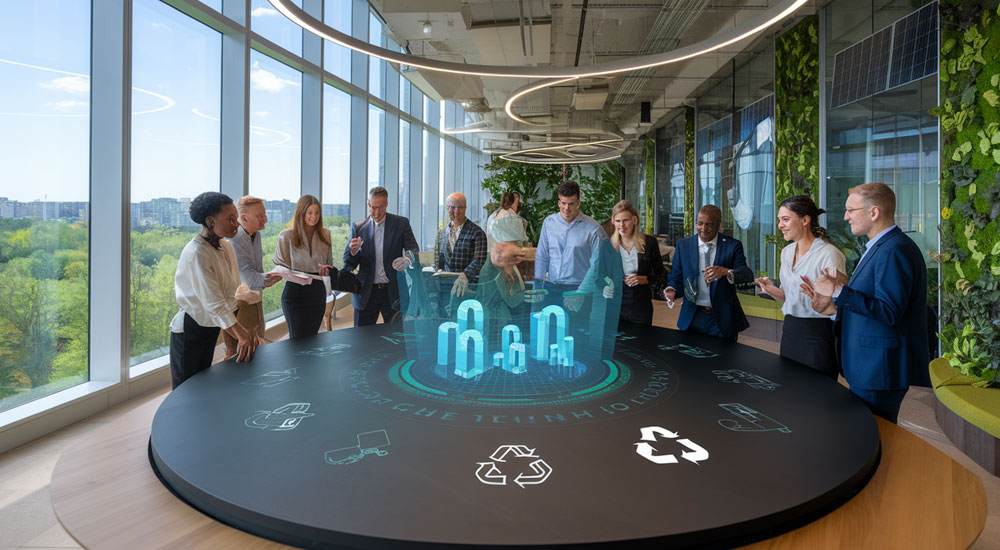Introduction
🌍 Business Implications of COP28- As the world gathers for COP28, businesses find themselves at a pivotal crossroads. The climate crisis is no longer a distant threat but an immediate challenge that demands action. Are you prepared for the seismic shifts in the business landscape that global climate goals will inevitably bring?
The decisions made at COP28 will reverberate through boardrooms and balance sheets across the globe. From carbon footprints to clean energy investments, from financial disclosures to corporate culture – every aspect of business is under the climate change microscope. But here’s the burning question: How can your company not just survive, but thrive in this new era of climate consciousness?
In this post, we’ll navigate the complex terrain of Business Implications of COP28, offering you a roadmap to align your company with global climate goals. We’ll explore everything from understanding the significance of COP28 to developing climate-aligned strategies, and from investing in clean technology to fostering a climate-conscious corporate culture. Buckle up as we embark on this crucial journey towards a sustainable future for your business and our planet. 🌱💼
Understanding COP28 and Its Significance
What is COP28?
COP28, or the 28th Conference of the Parties to the United Nations Framework Convention on Climate Change (UNFCCC), is a pivotal global climate summit. Held annually, these conferences bring together world leaders, policymakers, and stakeholders to address climate change challenges and set international climate action goals.
Key outcomes and agreements
The outcomes of COP28 have far-reaching implications for businesses worldwide. Here are the main agreements and their potential impact:
Enhanced emission reduction targets
Accelerated renewable energy adoption
Increased climate finance commitments
Strengthened adaptation and resilience measures
Agreement | Business Impact |
|---|---|
Emission reduction | Need for rapid decarbonization strategies |
Renewable energy | Opportunities in clean tech investments |
Climate finance | Access to funding for sustainable projects |
Adaptation measures | Demand for climate-resilient products and services |
Impact on global climate policy
COP28 has significantly influenced global climate policy, leading to:
Stricter regulations on greenhouse gas emissions
Incentives for clean energy adoption
Enhanced reporting requirements for climate-related risks
Increased international cooperation on climate action
Implications for businesses across sectors
The outcomes of COP28 have profound implications for businesses in various sectors:
Energy: Transition to renewable sources
Manufacturing: Adoption of sustainable production methods
Transportation: Shift towards electric and low-emission vehicles
Finance: Integration of climate risks in investment decisions
Agriculture: Implementation of climate-smart farming practices
Now that we have a clear understanding of COP28 and its significance, let’s delve into the key issues addressed at the conference.

Key Issues of COP28
A. Global Stock Take (GST) for Net-Zero Emissions
The Global Stock Take (GST) is a crucial component of COP28, aimed at assessing global progress towards achieving net-zero emissions. This process provides valuable insights for businesses to align their strategies with international climate goals.
Key aspects of the GST include:
Evaluating current emission reduction efforts
Identifying gaps in climate action
Recommending strategies for accelerated progress
GST Component | Business Implications |
|---|---|
Emission Reduction | Pressure to set more ambitious targets |
Gap Analysis | Opportunities for innovation and leadership |
Strategy Recommendations | Guidance for long-term planning |
B. Energy Efficiency and Renewable Energy
COP28 emphasizes the critical role of energy efficiency and renewable energy in combating climate change. Businesses are expected to:
Improve energy efficiency in operations
Invest in renewable energy sources
Develop innovative clean energy technologies
C. Climate-Friendly Sustainable Agriculture
Sustainable agriculture is a key focus at COP28, recognizing its potential to mitigate climate change while ensuring food security. Companies in the agricultural sector should consider:
Implementing regenerative farming practices
Reducing methane emissions from livestock
Developing climate-resilient crop varieties
D. Interconnection between Nature Conservation and Climate Action
COP28 highlights the synergy between biodiversity protection and climate mitigation. Businesses can contribute by:
Investing in nature-based solutions
Adopting sustainable resource management practices
Supporting ecosystem restoration projects
E. Adaptation and Support for Vulnerable Regions
As climate impacts intensify, COP28 emphasizes the need for adaptation strategies, particularly in vulnerable regions. Companies can play a role by:
Developing climate-resilient products and services
Supporting adaptation initiatives in vulnerable communities
Incorporating climate risk assessments in business planning
These key issues from COP28 provide a roadmap for businesses to align their strategies with global climate goals, fostering innovation and sustainable growth.
Assessing Your Company’s Carbon Footprint
Methods for measuring emissions
To effectively assess your company’s carbon footprint, it’s crucial to employ reliable methods for measuring emissions. Here are some widely-used approaches:
Direct measurement
Mass balance
Calculation-based methods
Emission factors
Method | Description | Best for |
|---|---|---|
Direct measurement | Uses continuous monitoring systems | Large stationary sources |
Mass balance | Tracks material and energy flows | Process industries |
Calculation-based | Uses activity data and emission factors | Most business operations |
Emission factors | Applies standardized factors to activities | Quick estimates |
Identifying major sources of carbon output
Once you’ve established a measurement method, the next step is to identify your company’s primary emission sources. Common areas to examine include:
Energy consumption in buildings and facilities
Transportation and logistics
Manufacturing processes
Supply chain activities
Waste management
Conduct a comprehensive audit to pinpoint the most significant contributors to your carbon footprint. This analysis will guide your reduction efforts and help prioritize actions.
Setting realistic reduction targets
With a clear understanding of your emissions profile, you can set achievable reduction targets. Consider these factors when establishing goals:
Industry benchmarks
Regulatory requirements
Technological feasibility
Financial implications
Stakeholder expectations
Align your targets with science-based methodologies to ensure they contribute meaningfully to global climate goals. Remember to set both short-term and long-term objectives to maintain momentum and track progress effectively.
Developing a Climate-Aligned Business Strategy
Integrating sustainability into core operations
To align your business strategy with global climate goals, it’s crucial to integrate sustainability into your core operations. This involves:
Conducting a sustainability audit
Setting clear, measurable sustainability targets
Redesigning processes to minimize environmental impact
Implementing sustainability KPIs across all departments
Here’s a comparison of traditional vs. sustainable operational approaches:
Area | Traditional Approach | Sustainable Approach |
|---|---|---|
Energy Use | Fossil fuel-dependent | Renewable energy sources |
Waste Management | Linear (produce, use, dispose) | Circular (reduce, reuse, recycle) |
Resource Consumption | Unlimited extraction | Responsible sourcing |
Employee Engagement | Profit-focused | Sustainability-driven culture |
Creating climate-conscious products and services
Developing products and services with a lower carbon footprint is essential. Consider:
Eco-friendly materials and packaging
Energy-efficient designs
Extended product lifecycles
Innovative, sustainable alternatives to existing offerings
Adapting supply chains for reduced emissions
Transforming your supply chain can significantly reduce your company’s overall emissions. Focus on:
Localizing suppliers to minimize transportation
Implementing green logistics solutions
Collaborating with suppliers on sustainability goals
Using data analytics to optimize routes and reduce waste
Embracing circular economy principles
Adopting circular economy practices can drive both sustainability and profitability:
Design out waste and pollution
Keep products and materials in use
Regenerate natural systems
By implementing these strategies, your company can align with global climate goals while potentially uncovering new business opportunities and enhancing brand reputation. As we move forward, it’s important to consider how investing in clean energy and technology can further support these efforts.
Investing in Clean Energy and Technology
A. Transitioning to renewable energy sources
Transitioning to renewable energy sources is a crucial step for companies aligning with global climate goals. This shift not only reduces carbon emissions but also offers long-term cost savings and energy security. Here’s a comparison of popular renewable energy options:
Energy Source | Pros | Cons |
|---|---|---|
Solar | Abundant, low maintenance | Weather-dependent, high initial cost |
Wind | Cost-effective, scalable | Location-specific, visual impact |
Hydroelectric | Reliable, long-lasting | Environmental impact, limited locations |
Geothermal | Consistent, low emissions | Geographically limited, high upfront costs |
Companies can start by:
Conducting energy audits to identify opportunities
Investing in on-site renewable energy installations
Purchasing renewable energy credits or power purchase agreements
B. Implementing energy-efficient processes
Energy efficiency is often the low-hanging fruit in sustainability efforts. Companies can:
Upgrade to energy-efficient lighting and appliances
Optimize HVAC systems
Implement smart building technologies
C. Exploring carbon capture and storage solutions
Carbon capture and storage (CCS) technologies are gaining traction as a way to mitigate emissions from hard-to-abate sectors. Companies can:
Invest in research and development of CCS technologies
Partner with CCS providers to offset emissions
Explore nature-based solutions like reforestation
D. Leveraging AI and IoT for sustainability
Artificial Intelligence (AI) and the Internet of Things (IoT) offer powerful tools for enhancing sustainability efforts. Applications include:
Predictive maintenance to reduce energy waste
Smart grid management for optimal energy distribution
Real-time emissions monitoring and reporting
By investing in these clean energy and technology solutions, companies can significantly reduce their carbon footprint while positioning themselves as leaders in the transition to a low-carbon economy.
Enhancing Climate-Related Financial Disclosures
Understanding TCFD recommendations
The Task Force on Climate-related Financial Disclosures (TCFD) provides a framework for companies to report on climate-related risks and opportunities. Here are the key components of TCFD recommendations:
Governance
Strategy
Risk Management
Metrics and Targets
Component | Description |
|---|---|
Governance | Board and management’s role in overseeing climate-related issues |
Strategy | Potential impacts of climate-related risks and opportunities on business strategy |
Risk Management | Processes for identifying, assessing, and managing climate-related risks |
Metrics and Targets | Metrics and targets used to assess and manage climate-related risks and opportunities |
Conducting climate-related risk assessments
To effectively assess climate-related risks, companies should:
Identify physical risks (e.g., extreme weather events)
Evaluate transition risks (e.g., policy changes, market shifts)
Assess potential financial impacts
Develop mitigation strategies
Improving transparency in sustainability reporting
Enhancing transparency in sustainability reporting involves:
Consistent and comparable data
Clear methodologies and assumptions
Regular updates and progress reports
Integration with financial reporting
By implementing these practices, companies can better align with global climate goals and meet stakeholder expectations for climate-related financial disclosures. This transparency not only aids in risk management but also positions companies as responsible corporate citizens in the face of growing climate concerns.
Collaborating for Climate Action
Joining industry-specific climate initiatives
Industry-specific climate initiatives offer businesses a powerful platform to collaborate and drive collective action towards sustainability. These initiatives provide:
Shared knowledge and best practices
Collective goal-setting and benchmarking
Access to resources and expertise
Here’s a comparison of notable industry climate initiatives:
Initiative | Focus Area | Key Benefits |
|---|---|---|
RE100 | Renewable energy | Commitment to 100% renewable electricity |
Science Based Targets | Emissions reduction | Alignment with Paris Agreement goals |
Climate Action 100+ | Investor engagement | Influencing high-emitting companies |
Partnering with NGOs and research institutions
Collaborating with NGOs and research institutions can enhance a company’s climate strategy by:
Accessing cutting-edge research and insights
Leveraging specialized expertise in sustainability
Enhancing credibility and transparency of climate efforts
Engaging in public-private partnerships
Public-private partnerships (PPPs) are crucial for addressing complex climate challenges. Benefits include:
Combining resources and capabilities
Scaling up climate solutions
Influencing policy and regulatory frameworks
Participating in carbon markets
Carbon markets offer a mechanism for companies to offset emissions and support climate projects. Key considerations:
Understanding different types of carbon credits
Ensuring quality and additionality of offset projects
Integrating carbon market participation into overall climate strategy
Now that we’ve explored collaboration strategies, let’s examine how to foster a climate-conscious corporate culture to ensure these efforts are embedded throughout the organization.
Fostering a Climate-Conscious Corporate Culture
Educating employees on climate issues
Fostering a climate-conscious corporate culture begins with education. Companies should implement comprehensive climate education programs to ensure all employees understand the urgency of climate action and its relevance to their roles.
Organize regular workshops and seminars
Provide access to online learning resources
Invite climate experts for guest lectures
Incentivizing sustainable practices
To drive meaningful change, companies must motivate employees to adopt sustainable practices both at work and in their personal lives. Implementing reward systems can significantly boost engagement and participation.
Incentive Type | Example |
|---|---|
Financial | Bonuses for sustainable innovations |
Recognition | “Green Employee of the Month” award |
Perks | Extra vacation days for carpooling |
Encouraging innovation in sustainability
Innovation is key to addressing climate challenges. Companies should create an environment that nurtures creative thinking and problem-solving in sustainability.
Establish dedicated “green teams” across departments
Host sustainability hackathons and idea competitions
Allocate resources for eco-friendly project development
By fostering a climate-conscious culture, companies not only contribute to global climate goals but also enhance their reputation, attract top talent, and drive long-term business success. This cultural shift sets the stage for navigating climate regulations and incentives, which we’ll explore in the next section.
Navigating Climate Regulations and Incentives
Staying compliant with evolving environmental laws
As environmental regulations become increasingly stringent, businesses must stay vigilant to ensure compliance. Here are key strategies:
Establish a dedicated compliance team
Regularly monitor regulatory updates
Implement robust environmental management systems
Conduct periodic internal audits
Capitalizing on green subsidies and tax breaks
Governments worldwide are offering incentives to promote sustainable practices. Companies can benefit from:
Incentive Type | Examples | Potential Benefits |
|---|---|---|
Tax Credits | Investment in renewable energy | Reduced tax liability |
Grants | Research and development in clean tech | Direct funding for projects |
Accelerated Depreciation | Purchase of energy-efficient equipment | Faster cost recovery |
Preparing for potential carbon pricing mechanisms
As carbon pricing becomes more prevalent, businesses should:
Conduct internal carbon pricing exercises
Assess supply chain vulnerabilities
Invest in emissions reduction technologies
Explore carbon offset opportunities
By proactively addressing these areas, companies can not only mitigate risks but also gain competitive advantages in an increasingly climate-conscious market. The key is to view climate regulations not as obstacles, but as catalysts for innovation and growth. As we move forward, it’s crucial to recognize that adapting to these changes is not just about compliance, but about positioning your business for long-term success in a low-carbon economy.
Conclusion
The outcomes of COP28 have set a new course for global climate action, presenting both challenges and opportunities for businesses worldwide. By understanding the key issues addressed at the conference and assessing their own carbon footprint, companies can develop climate-aligned strategies that not only meet regulatory requirements but also drive innovation and competitive advantage. Investing in clean energy, enhancing financial disclosures, and fostering collaboration are crucial steps in this journey.
As we move forward, businesses must recognize that addressing climate change is no longer optional but a fundamental aspect of corporate responsibility and long-term success. By embracing a climate-conscious corporate culture and navigating the evolving landscape of regulations and incentives, companies can position themselves as leaders in the transition to a sustainable, low-carbon economy. The time to act is now, and those who adapt swiftly and effectively will be best equipped to thrive in the climate-focused future that lies ahead.









